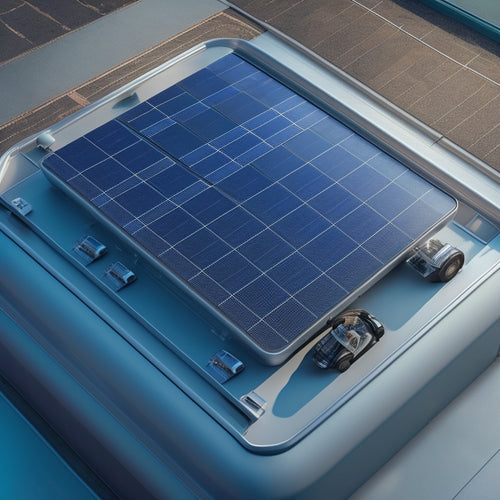
Installing Sun Panels on Your Roof in 5 Easy Steps
Share
You'll begin by evaluating your roof's suitability, checking its direction, shading, and condition to guarantee it can support solar panels. Next, you'll prepare your roof by performing necessary maintenance, obtaining permits, and trimming trees to maximize sunlight exposure. Then, you'll install the mounting system, connecting it securely to your roof. After that, you'll connect the solar panels, verifying their wiring and connections. Finally, you'll finalize the electrical connection, assuring safe and efficient energy transfer. With these 5 easy steps, you'll be well on your way to utilizing the power of the sun - and there's more to investigate to guarantee a successful installation.
Key Takeaways
- Assess your roof's suitability for solar panels, considering factors like orientation, shading, age, and local building codes.
- Prepare your roof for installation by performing necessary maintenance, obtaining permits, and trimming trees or vegetation.
- Install a secure and watertight mounting system, choosing the right type for your roof structure and codes.
- Connect solar panels to the mounting system, wiring them in series and following manufacturer instructions for optimal output.
- Finalize electrical connections, ensuring secure wiring, proper grounding, and testing the system for functionality and safety.
Assess Your Roof's Suitability
Before you start planning your solar panel installation, take a closer look at your roof to determine if it's suitable for solar panels.
You'll want to assess the roof's orientation, as south-facing roofs receive the most sunlight. East- and west-facing roofs can also work, but north-facing roofs typically aren't ideal.
Next, perform a shading analysis to identify any obstacles that could block sunlight, such as trees, buildings, or chimneys. You can use online tools or consult with a professional to ascertain the amount of shade your roof receives throughout the day.
Consider the age and condition of your roof as well. Solar panels typically last 25 years or more, so you'll want to confirm your roof will last at least that long.
If your roof is nearing the end of its lifespan, it may be wise to replace it before installing solar panels.
Finally, check your local building codes and regulations to verify your roof can support the weight and installation of solar panels.
Prepare Your Roof for Installation
With your roof's suitability assessed, you're ready to prepare it for solar panel installation. Verify your roof is in good condition by performing necessary roof maintenance tasks, such as repairing damaged or missing shingles, and clearing debris like leaves and branches. This will prevent any delays or complications during the installation process.
Next, obtain the required solar permits from your local government. These permits typically include a building permit, electrical permit, and a permit from your utility company. The specific permits required may vary depending on your location, so be sure to check with your local authorities.
Additionally, trim back any trees or vegetation that may be shading your roof or obstructing the installation process. This will guarantee that your solar panels receive maximum sunlight exposure and operate at peak efficiency.
Install the Mounting System
You'll begin the installation process by attaching the mounting system to your roof. This involves securing the racking system, which includes the rails, clamps, and flashing, to guarantee a watertight seal.
There are two primary mounting types: roof-ground mounts and ballasted mounts. Roof-ground mounts are secured directly to the roof deck, while ballasted mounts use weights to hold the system in place. Choose the mounting type that best suits your roof's structure and local building codes.
Next, gather the necessary installation tools, including a drill, impact driver, and socket set. Use these tools to secure the mounting system to your roof, following the manufacturer's instructions.
Verify the system is level, plumb, and securely fastened to withstand environmental factors like wind and snow. Properly installed, the mounting system will provide a solid foundation for your solar panels, allowing them to operate at maximum efficiency.
Connect the Solar Panels
Now that the mounting system is securely in place, it's time to connect the solar panels. You'll need to verify the panels are properly wired and connected to each other, as well as to the mounting system.
Start by identifying the solar panel types you're using, as different types may have varying connection requirements. For example, monocrystalline panels may require a specific wiring technique to optimize energy output.
When connecting the panels, use industry-approved wiring techniques to verify safe and efficient energy transfer. Use weather-resistant connectors and cables to withstand outdoor conditions.
Begin by connecting the panels in series, following the manufacturer's instructions for polarity and voltage. Make sure to secure the cables to the mounting system using cable ties or clamps to prevent damage or disconnection.
As you connect the panels, double-check your work to verify all connections are secure and properly insulated. Remember to follow local electrical codes and regulations, and consider consulting a professional if you're unsure about any aspect of the connection process.
Finalize the Electrical Connection
The electrical connection's final stage involves linking the solar panel array to the inverter, which converts DC power into usable AC electricity for your home. This connection is critical, as it enables your solar panel system to feed electricity into your home's electrical grid.
To finalize the electrical connection, you'll need to:
-
Verify safety precautions: Confirm all wiring connections are secure, and the system is grounded to prevent electrical shock.
-
Choose the right wiring types: Use wiring rated for outdoor use and suitable for the voltage and current output of your solar panel system.
-
Connect the inverter to the electrical panel: Follow the manufacturer's instructions to connect the inverter to your home's electrical panel, guaranteeing a safe and efficient transfer of power.
- Test the system: Perform a series of tests to verify the system is functioning correctly, including checking voltage, current, and power output.
Remember to consult your local electrical codes and regulations, and consider hiring a licensed electrician if you're not comfortable with the electrical connection process.
Frequently Asked Questions
How Long Do Solar Panels Last Before They Need to Be Replaced?
You're wondering how long solar panels last before needing replacement? Typically, they have a 25-30 year solar panel lifespan, but with regular solar panel maintenance, you can extend their life, ensuring consistent energy output and maximum ROI on your investment.
Can I Install Solar Panels on a Metal Roof?
As you catapult into the solar age, you're likely wondering: can I install solar panels on a metal roof? Yes, you can! Metal roof advantages include durability and minimal maintenance; however, installation considerations include ensuring a secure fastening system to withstand wind and weather.
Will Solar Panels Increase My Property Value?
You'll likely see a significant return on investment as solar panels enhance your property value, with a property appraisal reflecting the added worth, making your home more attractive to potential buyers and increasing its resale value.
Can I Install Solar Panels Myself to Save Money?
You can attempt a DIY solar installation to save money, but be warned: it's a complex process requiring specialized skills and equipment, and mistakes can compromise system efficiency and safety, potentially offsetting any cost savings.
Are There Any Local or State Incentives for Solar Panel Installation?
You're showered with incentives! You'll uncover a wealth of local and state programs offering juicy tax credits, rebates, and discounts, making your solar panel installation a financially savvy move that'll leave you feeling like a genius!
Related Posts
-

Charging Points in Rural Areas: 5 Key Insights
When driving through rural areas, you'll face a shortage of charging points, making EV ownership stressful and inconv...
-

Top Solar Panels for Car Battery Maintenance
When selecting top solar panels for car battery maintenance, consider high-efficiency models with high wattage output...
-

7 Ways to Save on Residential Home Solar Panels
You can save thousands on your residential home solar panels by leveraging financial incentives, dealer offers, and s...


